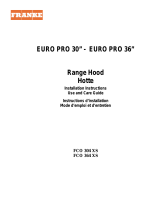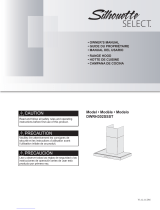Faber CRIS30SS300
The Faber CRIS30SS300 is a high-quality stainless steel slideout rangehood designed to effectively remove cooking fumes and odors from your kitchen. With its powerful motor and efficient design, this rangehood provides optimal ventilation and a cleaner, healthier cooking environment.
The slideout feature allows for easy access to the filters for cleaning and maintenance, ensuring that your rangehood continues to perform at its best. The included dishwasher-safe filters make cleaning a breeze, saving you time and effort.
The CRIS30SS300 is designed to be installed either through the wall or the roof, providing you with flexibility in choosing the most suitable venting method for your kitchen layout. The rangehood's compact design makes it ideal for smaller kitchens or those with limited space, while its sleek stainless steel finish adds a touch of modern elegance to any décor.
Faber CRIS30SS300
The Faber CRIS30SS300 is a high-quality stainless steel slideout rangehood designed to effectively remove cooking fumes and odors from your kitchen. With its powerful motor and efficient design, this rangehood provides optimal ventilation and a cleaner, healthier cooking environment.
The slideout feature allows for easy access to the filters for cleaning and maintenance, ensuring that your rangehood continues to perform at its best. The included dishwasher-safe filters make cleaning a breeze, saving you time and effort.
The CRIS30SS300 is designed to be installed either through the wall or the roof, providing you with flexibility in choosing the most suitable venting method for your kitchen layout. The rangehood's compact design makes it ideal for smaller kitchens or those with limited space, while its sleek stainless steel finish adds a touch of modern elegance to any décor.
















-
 1
1
-
 2
2
-
 3
3
-
 4
4
-
 5
5
-
 6
6
-
 7
7
-
 8
8
-
 9
9
-
 10
10
-
 11
11
-
 12
12
-
 13
13
-
 14
14
-
 15
15
-
 16
16
Faber CRIS30SS300
The Faber CRIS30SS300 is a high-quality stainless steel slideout rangehood designed to effectively remove cooking fumes and odors from your kitchen. With its powerful motor and efficient design, this rangehood provides optimal ventilation and a cleaner, healthier cooking environment.
The slideout feature allows for easy access to the filters for cleaning and maintenance, ensuring that your rangehood continues to perform at its best. The included dishwasher-safe filters make cleaning a breeze, saving you time and effort.
The CRIS30SS300 is designed to be installed either through the wall or the roof, providing you with flexibility in choosing the most suitable venting method for your kitchen layout. The rangehood's compact design makes it ideal for smaller kitchens or those with limited space, while its sleek stainless steel finish adds a touch of modern elegance to any décor.
Ask a question and I''ll find the answer in the document
Finding information in a document is now easier with AI
in other languages
- français: Faber CRIS30SS300 Mode d'emploi
Related papers
-
Faber CRIS30SSH300 cristalhcSSinstall
-
Faber CRIS30SSH300 Installation Instructions (PDF)
-
Faber CRIS36SSH300 User guide
-
Faber 6048624 User manual
-
Faber 630006509 User manual
-
Faber Velvet Installation guide
-
Faber Velvet Installation guide
-
Faber 5x20 5A User manual
-
Faber CRISTAL HC User manual
-
Faber CRIS24SS300 User guide
Other documents
-
Bertazzoni KTV30XV Installation guide
-
 Franke Consumer Products FCO 304 XS User manual
Franke Consumer Products FCO 304 XS User manual
-
Bertazzoni KTV24XV Installation guide
-
 Silhouette Select DWRH302SSST Owner's manual
Silhouette Select DWRH302SSST Owner's manual
-
Yes UVW9361BLTS User guide
-
Bosch DHL 755 B Installation guide
-
Electrolux EFC9588X User manual
-
XO T18 Ducted Hood User manual
-
GE JV695 User manual
-
ROBINHOOD CU European Installation & Operating Manual

















